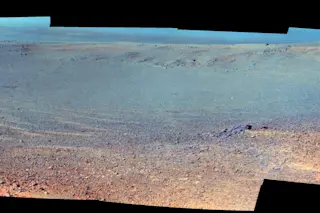The Opportunity rover, like its twin Spirit, was designed for an original mission of just three months. When engineers lost contact on June 10 of last year, it had been exploring for fourteen years. And today, mission scientists finally declared an official end to the mission. Here are just a few of Opportunity’s many successes during its long Red Planet expedition.
Opportunity discovered the first meteorite on Mars close to its own discarded heat shield. (Credit: NASA/JPL/Cornell)
NASA/JPL/Cornell
Opportunity discovered the first meteorite on Mars, sitting near its own heat shield. While a few meteorites had been found on the moon, this was the first time one was discovered on another planet. It’s mostly made of nickel and iron, a type of meteorite that’s rarely found on Earth. Opportunity went on to find more meteorites, both metallic and stony.
The small, round, bluish stones Opportunity found were likely formed in ...














